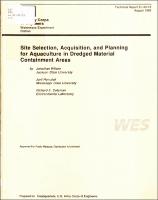Please use this identifier to cite or link to this item:
https://hdl.handle.net/11681/26358| Title: | Site selection, acquisition, and planning for aquaculture in dredged material containment areas |
| Authors: | Homziak, Jurij Coleman, Richard E. Wilson, Jonathan |
| Keywords: | Fish ponds Dredging spoil--Environmental aspects Fish culture Aquaculture engineering |
| Publisher: | Environmental Laboratory (U.S.) U.S. Army Engineer Waterways Experiment Station. |
| Series/Report no.: | Technical Report;EL-93-13 |
| Abstract: | High land and construction costs hinder development of pond-based aquaculture in the United States. A partnership with the U.S. Army Corps of Engineers (USACE) may reduce these constraints. The dredged material containment areas (DMCA) operated by the Corps are structurally similar to aquaculture ponds and typically are used by the USACE only once every 3 to 10 years. With the Corps and navigational interests contributing to dike construction and land acquisition, the costs of aquaculture may be reduced while providing the Corps with the additional disposal areas needed to maintain our nation's waterways. The Containment Area Aquaculture Program was established to investigate the feasibility of DMCA aquaculture from biological, economic, engineering, and legal perspectives. The technical feasibility of DMCA aquaculture was demonstrated in 42- and 47-ha DMCA's near Brownsville, TX. Pumps, filters, and drainage structures were added to these DMCA's to accommodate aquaculture operations and a 1.6-ha nursery pond was constructed. During a 3-year period, four crops of penaeid shrimp were raised. Production rates averaged 670 kg/ha of whole shrimp (range: 338 to 1,143 kg/ha) with 51 percent survival (range: 23 to 74 percent). Total production for the four crops was 116,088 kg of whole shrimp (71,878 kg tails) which was sold for over $475,000. This report gives a general overview of site selection considerations when colocating a DMCA and an aquaculture facility. Checklists are given to provide aquaculturists, USACE personnel, regulatory agencies, and others with a summary and quick reference to important factors in choosing a site. Site selection is the most important decision made in any large-scale pond aquaculture operation, regardless of whether the operation will be in a DMCA. Establishment and operation of a DMCA aquaculture facility will typically require close cooperation between the aquaculturist, local dredging sponsor, and USACE district. A general screening of potential sites can be made by examining dredging records to determine if dredging needs coincide with areas feasible for aquaculture operations. In doing this assessment, future site conditions, management strategies, and design modifications should be anticipated to the extent practicable. Other factors to consider include: area available for development, compatibility with adjacent land uses, zoning or legal restrictions, topography, general soil types, and proximity to service and support systems. After this preliminary survey is completed and species and culture methods are chosen, a more detailed evaluation that focuses upon aquaculture operations should be conducted. In general, the typical design criteria for DMCA's (most notably the water control structures and bottom slope) must be modified to accommodate an aquaculture operation; therefore, effort should be spent detailing the modifications needed and their cost. |
| URI: | http://hdl.handle.net/11681/26358 |
| Appears in Collections: | Technical Report |
Files in This Item:
| File | Description | Size | Format | |
|---|---|---|---|---|
| TR EL-93-13.pdf | 7.11 MB | Adobe PDF |  View/Open |